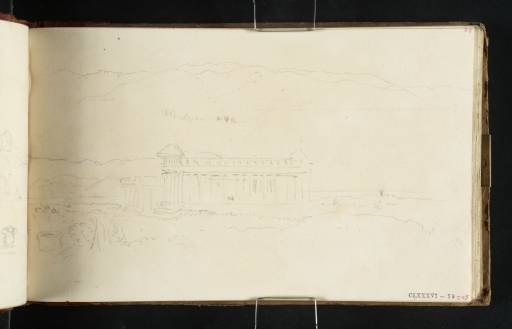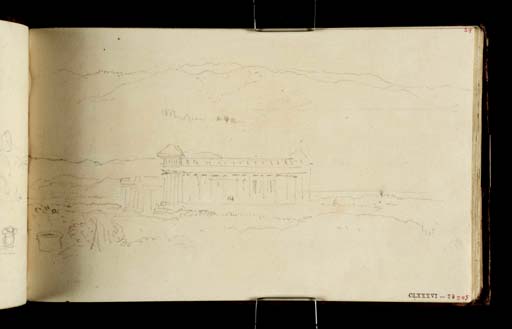Joseph Mallord William Turner The Temples of Hera, Paestum 1819
Image 1 of 2
Joseph Mallord William Turner,
The Temples of Hera, Paestum
1819
Joseph Mallord William Turner 1775–1851
Folio 31 Recto:
The Temples of Hera, Paestum 1819
D15968
Turner Bequest CLXXXVI 29
Turner Bequest CLXXXVI 29
Pencil on white wove paper, 113 x 189 mm
Inscribed by the artist in pencil ‘14’ with sketch of temple’
Inscribed by ?John Ruskin in red ink ‘29’ top right and ‘245’ bottom right
Stamped in black ‘CLXXXVI 29’ bottom right
Inscribed by ?John Ruskin in red ink ‘29’ top right and ‘245’ bottom right
Stamped in black ‘CLXXXVI 29’ bottom right
Accepted by the nation as part of the Turner Bequest 1856
References
1909
A.J. Finberg, A Complete Inventory of the Drawings of the Turner Bequest, London 1909, vol.I, p.552, as ‘Temple at Pæstum’.
1983
Cecilia Powell, ‘Turner’s Vignettes and the Making of Rogers’s “Italy”, Turner Studies, Summer 1983, vol.3, no.1, p.8.
1984
Cecilia Powell, ‘Turner on Classic Ground: His Visits to Central and Southern Italy and Related Paintings and Drawings’, unpublished Ph.D thesis, Courtauld Institute of Art, University of London 1984, pp.190 note 91, 425, 535–6 note 26, as ‘The Temple of Neptune and the Basilica from near the Temple of Ceres’.
1987
Cecilia Powell, Turner in the South: Rome, Naples, Florence, New Haven and London 1987, p.83 note 71.
1993
Dr Jan Piggott, Turner’s Vignettes, exhibition catalogue, Tate Gallery, London 1993, p.82 nos.6 and 7.
The southernmost destination on Turner’s tour of Italy in 1819–20 was Paestum, an ancient city on the Tyrrhenian coast, approximately twenty miles south-east of Salerno. Here, like many British tourists, the artist visited the three famous fifth-century BC Greek Doric temples which stand on a plain between the Lattari mountains and the Tyrrehenian sea. Rediscovered in the mid-eighteenth century, the remains represented some of the most well preserved and complete temples in Europe, and according to Revd John Chetwode Eustace in A Classical Tour Through Italy (first published 1813), surpassed those in every other Italian city except Rome.1 Turner was already familiar with the appearance of the ruins through the work of other artists including Giovanni Battista Piranesi (1720–1778),2 John Robert Cozens (1752–1797),3 John ‘Warwick’ Smith (1749–1831),4 and James Hakewill (1778–1843).5 Furthermore he had used an illustrated diagram featuring the so-called Temple of Neptune in his perspective lectures at the Royal Academy (see Tate D17072; Turner Bequest CXCV 102). Having made the journey from Naples to Paestum for himself he eagerly seized the opportunity to make a number of on-the-spot sketches, exploring the site from a variety of angles, see folios 19 verso, 20, 31–33 verso, 44 verso–45 verso (D15945, D15946, D15968–D15973, D15995–D15997; Turner Bequest CLXXXVI 19a, 19b, 29–31a, 42a–43a). This sketch depicts a view of the Second Temple of Hera (formerly known as the Temple of Neptune). 6 Visible beyond is the adjacent Temple of Hera, commonly but mistakenly known as the Basilica. Turner’s viewpoint looks south-west in the direction of the sea but at the top of the sheet he has also added an outline study of the mountainous vista seen in the opposite direction.
The temples at Paestum later formed the subject for one of Turner’s vignette illustrations for Rogers’s Italy, published 1830 (see Tate D27665; Turner Bequest CCLXXX 148). He does not appear, however, to have consulted his on-the-spot sketches from 1819, instead relying on imagination and memory for the composition.7 Within this study for example he has noted that there are ‘14’ Doric columns along the lateral side of the Second Temple of Hera, a fact which he had also recorded in his notes from Eustace in the Italian Guide Book sketchbook (see Tate D13958; Turner Bequest CLXXII 14a). However, in his watercolour design for the vignette he erroneously depicted the same structure as a regular Roman temple with six columns on the façade and eleven along the side, and moreover not as a ruin but as a complete building.8
Nicola Moorby
July 2010
John Chetwode Eustace, A Classical Tour Through Italy, London 1815, 3rd edition, vol.III, pp.76–108.
For example, The Two Temples at Paestum,1782 (Victoria and Albert Museum, London), reproduced in Giuliano Briganti, Nicola Spinosa and Lindsay Stainton, In the Shadow of Vesuvius: Views of Naples from Baroque to Romanticism 1631–1830, exhibition catalogue, Accademia Italiana delle Arti e dell arti Applicate, London 1990, p.70.
See Tony Cubberley and Luke Herrmann, Twilight of the Grand Tour: A catalogue of the drawings by James Hakewill in the British School at Rome Library, Rome 1992, no.5.58, reproduced p.290.
See also W.G. Rawlinson, The Engraved Work of J.M.W. Turner, R.A., London 1908, vol.II, no.799 (Tate, T04914).
How to cite
Nicola Moorby, ‘The Temples of Hera, Paestum 1819 by Joseph Mallord William Turner’, catalogue entry, July 2010, in David Blayney Brown (ed.), J.M.W. Turner: Sketchbooks, Drawings and Watercolours, Tate Research Publication, December 2012, https://www


